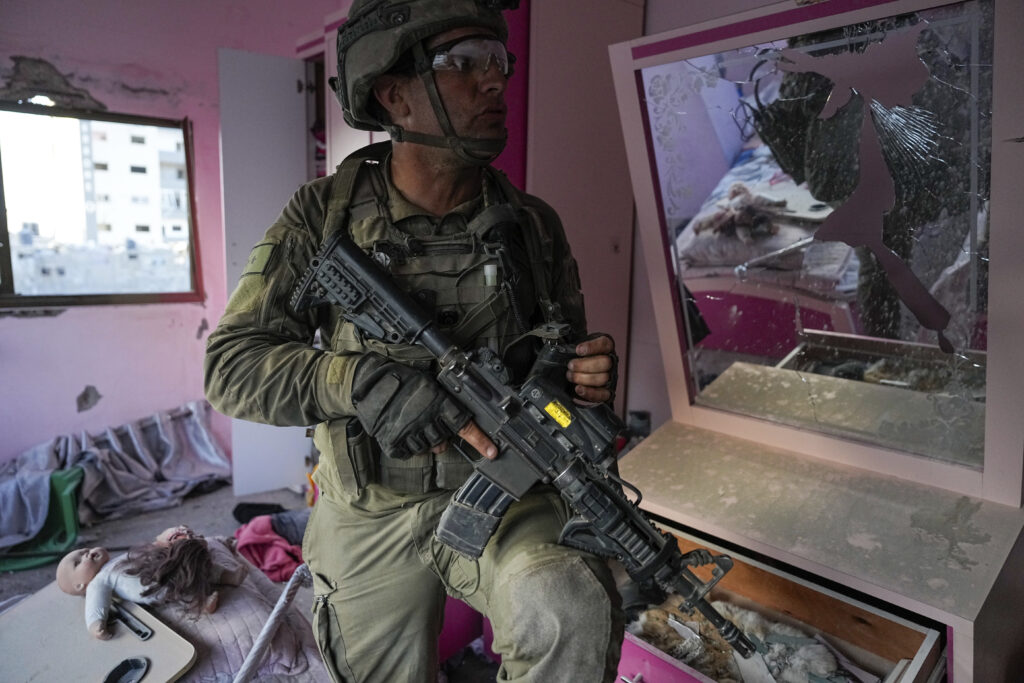
An Israeli soldier stands in an apartment during a ground operation in the Gaza Strip, Wednesday, Nov. 8, 2023. Israeli ground forces entered the Gaza Strip as they press ahead with their war against Hamas militants in retaliation for the group's unprecedented Oct. 7 attack on Israel. (AP Photo/Ohad Zwigenberg)
Crowds of Palestinian families stretching as far as the eye could see walked out of Gaza City and surrounding areas toward the south Thursday to escape Israeli strikes and ground troops battling Hamas militants in dense urban neighborhoods. Others joined tens of thousands taking shelter at the city’s biggest hospital, not far from the fighting.
Gaza’s largest city is the focus of Israel’s campaign to crush Hamas following its deadly Oct. 7 incursion — and the Israeli military says Hamas’ main command center is located in and under the Shifa Hospital complex. The militant group and hospital staff deny that claim.
Growing numbers of people have been living in and around the hospital complex, hoping it will be safer than their homes or U.N. shelters in the north, several of which have been hit repeatedly. Israeli troops were around 3 kilometers (2 miles) from the hospital, according to its director.
The accelerating exodus to the south came as Israel agreed to put in place four-hour daily humanitarian pauses and to open a second route for people to flee the north, the White House said. The scope of the pauses was not immediately clear. The agreement came as Western and Arab officials gathered in Paris on Thursday to discuss ways of providing more aid to civilians in Gaza.
BATTLES NEAR SHIFA HOSPITAL
Israeli ground forces battled near Gaza’s largest hospital, Shifa. Conditions are worsening for tens of thousands of people sheltering there, said three people who had left the hospital to go south in the past two days.
Families are sleeping in hospital rooms, even surgical theaters and the maternity ward, or on the streets outside. Daily food distributions helped a tiny number for a time, but there has been no bread for the past four days, they said. Water is scarce and usually polluted, and few people can bathe. They spoke on condition of anonymity for fear of reprisals.
The hospital has also been overwhelmed with daily waves of wounded from airstrikes, while medical supplies have been running low and electricity has been shut off in large sections of the facility. The U.N. was able to deliver two truckloads of supplies Wednesday night, only the second delivery since the war began — enough to last a few hours, the director said.
Dozens of wounded were rushed to Shifa overnight, and a shell hit close to the hospital around dawn, thought it caused only a few minor injuries, the director Mohammed Abu Selmia told The Associated Press on Thursday.
“The conditions here are disastrous in every sense of the word,” he said. “We’re short on medicine and equipment, and the doctors and nurses are exhausted. … We’re unable to do much for the patients.”
International journalists who entered the north on a tour led by the Israeli military on Wednesday saw heavily damaged buildings, fields of rubble and toppled trees along the Mediterranean shoreline.
DETERIORATING CONDITIONS IN GAZA
The trickle of aid entering Gaza from the south is largely barred from going north, which has been without running water for weeks. The U.N. aid office said all the bakeries there have shut down for lack of fuel, water and flour. Hospitals running low on supplies are performing surgeries without anesthesia.
More than two-thirds of Gaza’s population of 2.3 million have fled their homes since the war began, with many heeding Israeli orders to flee to the southern part of the besieged enclave.
But the conditions there are also dire. Israel has continued to strike what it says are militant targets all across the territory. New arrivals from the north are squeezing into homes with extended family, or into U.N. schools-turned-shelters.
The World Health Organization said a lack of clean water and bathing facilities in shelters across Gaza has fueled the spread of infectious diseases, including scabies, lice, chickenpox, skin rash and respiratory illness. It has logged over 33,000 cases of diarrhea since mid-October — more than half among children under 5.
A QUICKENING EXODUS
Still, the exodus from Gaza City and surrounding areas in the north has accelerated in recent days. The U.N. Office for the Coordination of Humanitarian Affairs said 50,000 people fled south on Gaza’s main highway on Wednesday during a daily, hourslong window announced by the Israeli military. There are clashes and shelling near the road, and evacuees reported seeing corpses alongside it, the U.N. office said.
Similar-sized crowds streamed out on Thursday, according to an Associated Pres reporter on the scene as they arrived out of the northern zone. Most are traveling on foot with only what they can carry, many holding children or pushing older relatives in carts.
“We’ve been expelled, we’ve been put through a catastrophe. And who knows what more is coming,” said Kamal Nusseir, a 28-year-old with his possessions tied to his back.
His use of the Arabic word “nakba,” — which literally means “catastophe” — is a reference to the expulsion or flight of some 700,000 Palestinians from their homes in what is now Israel during the 1948 war around Israel’s creation. More than half of Gaza‘s residents are refugees from that war, or their descendants.
Israeli officials say thousands of Palestinian militants have been killed, and blame civilian deaths on Hamas, accusing it of operating in residential areas and using Palestinian civilians as human shields. Gaza’s Health Ministry does not distinguish between civilians and combatants in its casualty reports.
The occupied West Bank has also seen a surge in violence, with Israel carrying out frequent arrest raids that often spark gunbattles. At least seven Palestinians were killed Thursday during a raid in Jenin, according to the Palestinian Health Ministry. The military says it has stepped up operations to prevent attacks.
More than 1,400 people have died in Israel since the start of the war, most of them civilians killed by Hamas militants during their initial incursion. Israel says 32 of its soldiers have been killed in Gaza since the ground offensive began.
Palestinian militants have continued to fire rockets into Israel, and some 250,000 Israelis have been forced to evacuate from communities near Gaza and along the northern border with Lebanon, where Israeli forces and Hezbollah militants have traded fire repeatedly.
___
Magdy reported from Cairo and Chehayeb from Beirut. Associated Press writers Amy Teibel and Isabel DeBre in Jerusalem and Matthew Lee in Washington contributed to this report.





